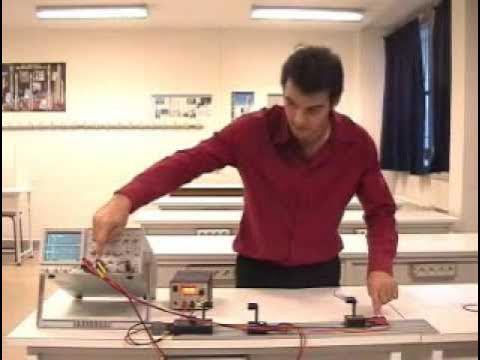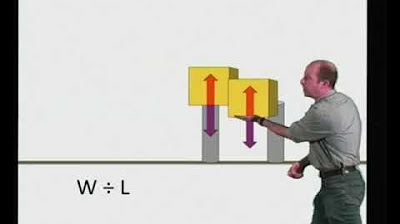Trajectory of a projectile with linear drag
Summary
TLDRDans cette vidéo, l'analyse du trajectoire d'un projectile soumis à une force de trainée proportionnelle à sa propre vitesse est présentée. Après avoir établi les équations paramétriques de x et y en fonction du temps, la vidéo combine ces équations pour obtenir une équation cartésienne de la trajectoire. La trajectoire, affectée par la résistance de l'air, perd sa symétrie typique pour une trajectoire sans air resistance. Les conditions initiales et la résolution des équations différentielles permettent de trouver les expressions de x(t) et y(t), et finalement, une équation de trajectoire en fonction de x révèle une forme moins symétrique et plus verticale à mesure que le projectile avance.
Takeaways
- 🔍 L'analyse porte sur la trajectoire d'un projectile soumis à une force de drag proportionnelle à sa propre vitesse.
- 📐 La trajectoire est décrite par des équations paramétriques en x et y en fonction du temps, qui sont ensuite combinées pour obtenir une équation cartésienne.
- 📉 La présence de la résistance de l'air altère la forme de la trajectoire, qui n'est plus symétrique comme dans le cas sans résistance.
- ⏳ L'application de la deuxième loi de Newton en forme vectorielle permet d'établir un lien entre les forces agissant sur le projectile et son accélération.
- 🧮 Les équations différentielles pour x et y sont résolues en utilisant des méthodes standard, notamment en cherchant des solutions exponentielles pour l'équation sans force de gravitation.
- 🔄 La solution générale pour x en fonction du temps est une combinaison linéaire de deux solutions, l'une constante et l'autre décroissant exponentiellement.
- 🎯 Les conditions initiales (position et vitesse initiales) sont appliquées pour déterminer les constantes dans les équations de la trajectoire.
- 📉 L'équation différentielle pour y inclut une composante de force de gravitation, qui nécessite une solution en deux parties : la fonction complémentaire et l'intégrale particulière.
- 📌 La forme de la trajectoire est affectée par la résistance de l'air, qui ralentit le composant horizontal de la vitesse, rendant la trajectoire plus vertical à mesure que le projectile avance.
- 🧐 L'équation cartésienne finale de la trajectoire montre une dépendance en logaritme de la distance x, ce qui reflète la diminution de la vitesse horizontale due à la résistance de l'air.
Q & A
Quelle est la force de trainée (drag force) décrite dans le script ?
-La force de trainée est une force proportionnelle à la vitesse de l'objet, notée comme -b * v, où b est une constante et v est la vitesse du projectile.
Quels sont les deux principaux composants de la force qui agit sur le projectile dans le script ?
-Les deux principaux composants de la force sont la gravité, qui agit垂直向下, et la force de trainée (air resistance force), qui est proportionnelle à la vitesse du projectile.
Comment le script utilise-t-il la deuxième loi de Newton pour analyser le mouvement du projectile ?
-Le script utilise la deuxième loi de Newton, qui relie la force à l'accélération, pour établir des équations différentielles pour les composantes x et y de la position du projectile.
Quelle est la forme vectorielle de l'équation de la deuxième loi de Newton appliquée au projectile ?
-La forme vectorielle est F = m * a, où F représente la force resultante, m est la masse du projectile, et a est l'accélération, notée comme r'', où r est le vecteur de position.
Comment le script décompose l'équation vectorielle en composantes x et y ?
-Le script décompose l'équation en deux équations séparées pour les composantes x et y, en prenant en compte la force de trainée et la gravité, et en utilisant les notations x'', y'', x', et y' pour les dérivées temporelles des coordonnées.
Quelle est la solution générale pour la composante x du mouvement du projectile ?
-La solution générale pour x(t) est une combinaison linéaire de deux solutions: une constante (a) et une fonction exponentielle décroissante (b * e^(-b*t/m)), où a et b sont des constantes déterminées par les conditions initiales.
Comment le script résout l'équation différentielle pour la composante y en prenant en compte la force de trainée et la gravité ?
-Le script résout l'équation pour y(t) en trouvant d'abord la fonction complémentaire (solution homogénéisée), puis en ajoutant une intégrale particulière basée sur une conjecture informée pour tenir compte de la force de trainée et de la gravité.
Quels sont les deux principaux termes dans la solution générale pour y(t) ?
-Les deux principaux termes sont la fonction complémentaire, qui est une fonction exponentielle, et l'intégrale particulière, qui est une combinaison linéaire de t et de t², ajustée pour équilibrer la force de trainée et la gravité.
Comment le script utilise-t-il les conditions initiales pour déterminer les constantes dans les équations de mouvement ?
-Le script applique les conditions initiales (position et vitesse au début du mouvement) pour résoudre les équations et trouver les valeurs des constantes a et b dans les expressions x(t) et y(t).
Quelle est la forme finale de l'équation cartésienne pour le trajectoire du projectile avec la force de trainée ?
-L'équation cartésienne finale est y = (b * u_y + mg / b) * x - (m^2 * g / b^2) * ln(1 - b * x / m * u_x), où b est la constante de trainée, u_x et u_y sont les composantes initiales de la vitesse, et g est l'accélération due à la gravité.
Outlines

This section is available to paid users only. Please upgrade to access this part.
Upgrade NowMindmap

This section is available to paid users only. Please upgrade to access this part.
Upgrade NowKeywords

This section is available to paid users only. Please upgrade to access this part.
Upgrade NowHighlights

This section is available to paid users only. Please upgrade to access this part.
Upgrade NowTranscripts

This section is available to paid users only. Please upgrade to access this part.
Upgrade NowBrowse More Related Video

L'effet piézoélectrique

Eureka (french) l'énergie cinétique - épisode 9

cours TS physique / onde: détermination de la célérité des ondes dans l'air

Le Travail Introduction

Why Heavy Leg Training Might be Hurting Your Progress - Only Do Training You Enjoy!

Mouvement dans un CHAMP ÉLECTRIQUE UNIFORME ✅ Terminale Spécialité
5.0 / 5 (0 votes)
